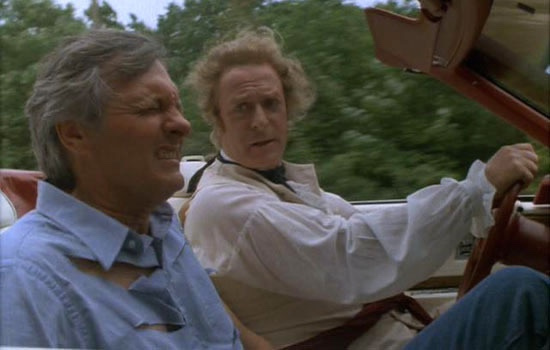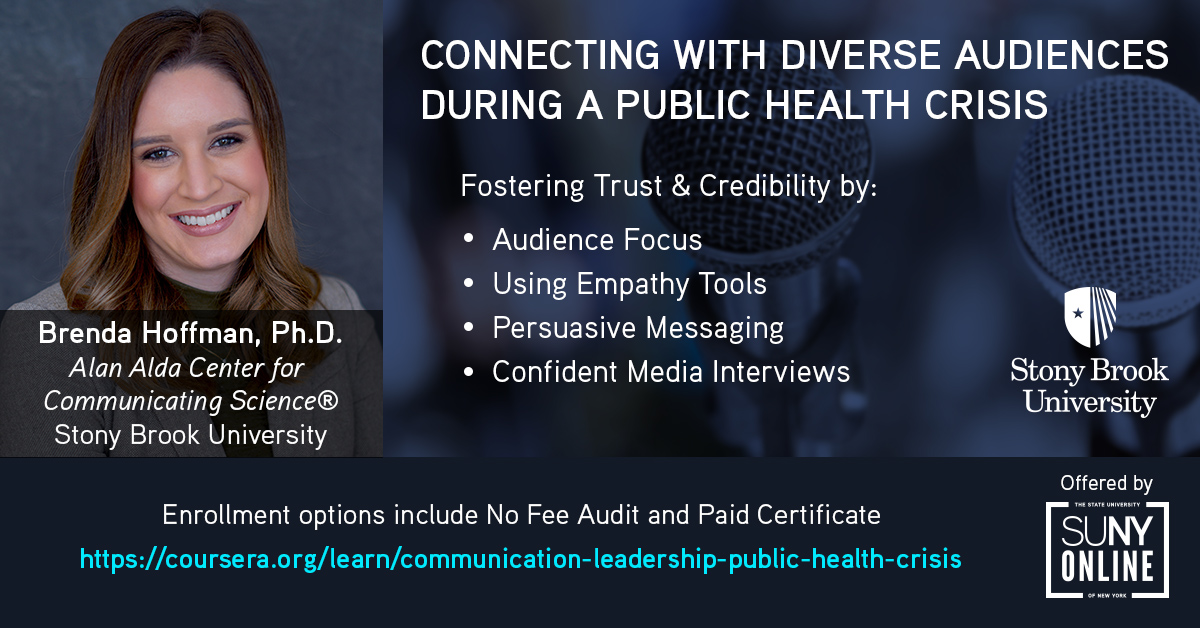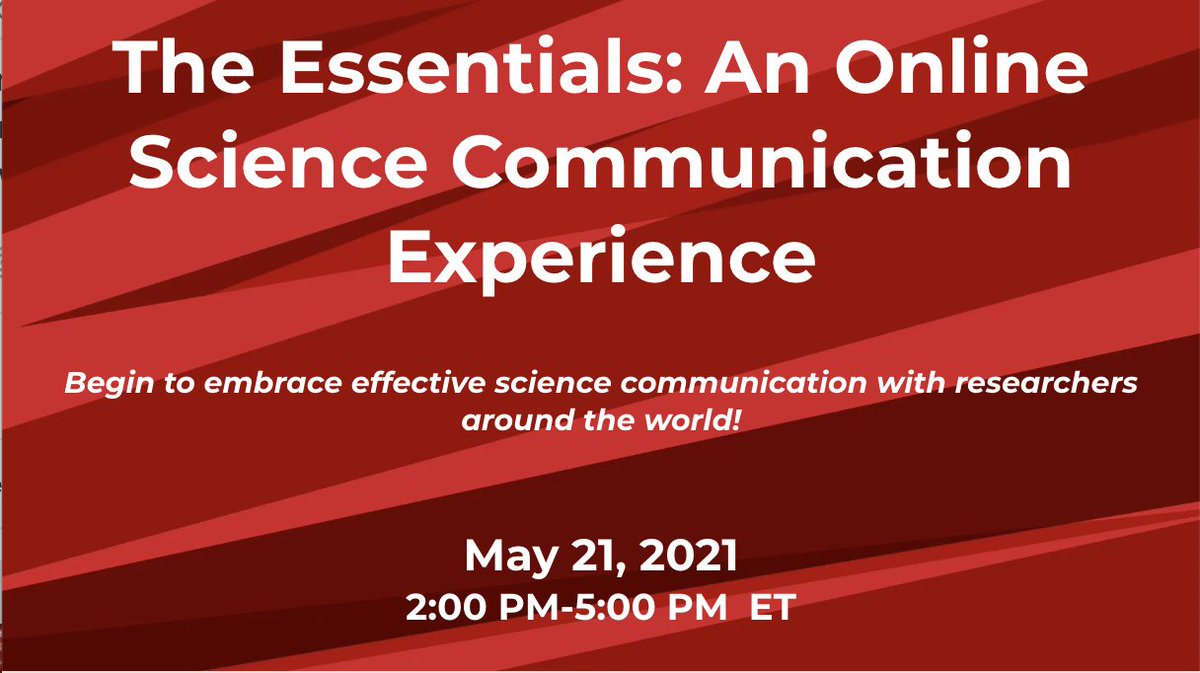Misconceptions in Science Communication
Part 1

As an emerging field, science communication (scicomm) is susceptible to many misconceptions, both from the researchers or communicators involved and from those outside looking in, such as academic advisors and industry representatives. Misconceptions in scicomm can run the gamut, from failing to understand the value of an audience-specific message to relying too heavily on facts and statistics to get a point across.
This article focuses on common misconceptions that surround the creation and sharing of scientific messages from the perspective of a science communicator, so whether you’re just getting started in scicomm or consider yourself a seasoned “commer,” you can review which pitfalls to avoid and ensure you craft a message that will resonate with your audience (almost) every time.
My name is Ellice, and I’m a student in the science communication graduate program here at Stony Brook University. I also run The Neuro Aesthetic, a blog and Instagram account aimed at helping PhD students and postdocs to find their unique voices in scicomm and recognize the value of creating aesthetic science content online.
On a mission to uncover which misconceptions scicommers encounter most frequently, I reached out to several science communicators in my network and asked them to share their perspectives based on their experience in the field. From graduate students to biologists to public health professionals, each of them shared misperceptions they faced at the beginning of their scicomm journey as well as those they are still learning to overcome.
While talking with everyone, it became clear to me that no two science communicators are alike, and neither are any two audiences. As a result, crafting a worthwhile and effective scientific message requires a multistage process, and the most common misconceptions surrounding message creation can be broadly classified into four categories: Pre-Communication, Message Drafting, Message Delivery,and Reflection.
Keep reading to find out how to navigate the often murky waters of scicomm.
Misconceptions Surrounding Pre-Communication
“Science communication doesn’t require intention.”
Actually, it does. Intention is step one in science communication. You can’t churn out science content willy nilly and expect it to fall on fertile ground. Yes, you might get lucky and have a post go viral, but intention is vital to continued success.
Dillon Jones is a biologist and science communicator who creates engaging science content on Instagram. He points out that there are several elements involved in having a public presence as a science communicator, including branding (who you will be and what you will represent in your content, as well as how you present it) and content consistency. These require a planned and intentional approach in order to be successful.
“It doesn’t matter who my audience is,” or “My audience is ‘the public.’”
It may surprise you to learn that there is no one such thing as “the public.” In fact, according to the Alda Method, there are several publics. Each audience will be composed of smaller groups with whom your message will land differently, based on their unique backgrounds, experiences, and beliefs. It is important to take this into consideration when crafting your message. If you need help defining your audience and tailoring your messages for them, consider taking an Alda Center workshop.
“I am the best communicator for my audience.”
We know you worked hard on your message and you’re passionate about sharing it. But depending on your topic, you may not be the person best equipped to share it with your intended audience if you want it to land well. Consider the example of an older, male researcher talking to an audience of high school girls about female reproductive health and trying to persuade them to practice safe sex. It is much more likely that a woman closer to their age presenting that message will garner more attention and have a better rapport with that audience, thereby increasing the chances that her message will be effective and have the desired effect on them.
Misconceptions Surrounding Message Drafting
“Just sharing cool science is good enough.”
Unfortunately, it’s not. Katrina Wesencraft, a PhD candidate and freelance content creator for NASA’s Citizen Science Accelerator, had to learn this through experience. “Initially, I didn’t appreciate that just sharing cool science isn’t enough,” she says. “There needs to be a purpose to your sci comm.” All science communication should have the goal of making an audience member either think, feel, or do something specific, or else it can easily get lost in the noise of all the other messaging that audiences receive on a daily basis.
“Good logic equals good communication.”
As scientists, we are trained to be objective and keep our emotions and biases out of our work, but this can be a curse when it comes to communicating our work with others. Emotions can, do, and should play a role in communication. Empathy is of particular importance, as it allows us to understand and connect with our audiences.
“If they knew enough about XYZ, they’d understand, and be on our side.”
The quote above comes from Stephanie Castillo, PhD candidate and video producer. Before starting her PhD in scicomm at Vanderbilt, she conformed to this way of thinking. “Now that I study the science of science communication, I know that this thought process falls under the deficit model, which no longer works,” she says. “It’s all about building community and valuing what others bring to the conversation too, regardless of education.”
Another avenue this thought process frequently takes is that if a person disagrees with a scientific message or has trouble comprehending it, that must mean they are uneducated.
This is unfair and discriminatory on multiple levels: a person may be highly educated but in a vastly different field such as law or business - they may simply be unfamiliar with the topic in the message. It is also potentially ableist, because if a person is neurodivergent, it could lead to differences in processing information that have absolutely nothing to do with their level of education or intelligence.
“Facts and statistics are enough.”
This misconception is similar to the last in that the communicator may believe quoting statistics or facts will persuade their audience. However, risk communication shows that statistics can easily be misinterpreted and statements can be taken out of context or misunderstood, especially when emotions are running high, such as when a hazard threatens a community. In the science of science communication, this is known as the deficit model, or the belief that simply adding to an audience’s repertoire of knowledge will increase their understanding, cooperation and interest in science. It doesn’t work.
“Because I understand it, it’s not jargon.”
I call this “the seminal quote of the Curse of Knowledge.” It is important not to forget where you came from; at one point, everyone was a beginner, and your familiarity with certain ideas and terms comes from constant exposure to them. Individuals in your audience may not have as much experience as you and as such may not be familiar with terms that have now become commonplace in your vocabulary.
Misconceptions Surrounding Message Delivery
“Repeating it helps.”
It’s tempting to repeat oneself when someone goes “What?” after we just finished explaining our favorite scientific topic to them. However, asking “what?,” in science communication usually doesn’t mean your audience didn’t hear you or that you need to repeat yourself slower, rather, it’s an indicator that your first explanation simply didn’t make sense to the listener.
Sometimes taking a pause and allowing our audience to think about what we’ve just told them allows them to think deeply and opens opportunities for questions. Consider finding another way to explain the topic, such as using an analogy or replacing technical words with simpler ones. Let your audience’s feedback guide you to a solution that resonates with them. Remember, as the expert, the onus is on you to make your work clear enough for your audience to understand - your audience shouldn’t be expected to do this for themselves.
“My message will be received by everyone in my audience the same way.”
Lumping everyone in your audience into one category is never a good idea. Remember earlier when we talked about different publics? It’s important to consider that there may be varying levels of ability within your audience, and make accommodations for that both when preparing your message and during delivery. For ideas on how to make your presentation more accessible, check out this in depth article.
“Sharing a message automatically ‘transmits’ an idea into a listener’s mind.”
Francis A. Cartier called this the myth of idea transmission. Based on this view, it is only as a result of unsuccessful communication attempts that a listener forms their own idea based on what they’ve heard rather than simply accepting the speaker’s message, but Cartier argues that there is only one way a listener ever acquires a new idea: by combining two or more ideas they already had in a different way, resulting in them either believing the message they are hearing, or choosing to disbelieve it.
You cannot, through sheer excellence, force an audience member to wholly accept your idea. It will always be modified through their previously held beliefs, experiences and worldviews. Once you are able to accept and incorporate this into your science communication strategies, you will be able to have more productive conversations surrounding science.
“Well, I told them about the dangers of (climate change, smoking, etc.), my work here is done.”
A common point where risk communication falls short is presenting an audience with a message and believing that’s the end of it. People need resources to help them stay the course after hearing a persuasive message, and providing actionable tips as well as a support system to help implement those tips are a good starting point for science communicators who wish to create lasting impact with their outreach.
Misconceptions Surrounding Message Reflection
“If people don’t agree, they misunderstood me.”
It’s possible to be overconfident in the truth of your message because it concerns a topic you’re passionate about, but people have different priorities and values, which makes the world a diverse and interesting place. Sometimes, those priorities will take precedence and lead to people disagreeing with you, even though they understood you just fine.
“Because, science.”
This is the expectation that someone should accept your claim at face value because you know it’s scientifically accurate, and it often stems from frustration and burnout. We get it, sometimes you’re just tired of arguing. But, using the “because, science” trope is a cop out, and following up your carefully designed message with this will undoubtedly cause it to fall flat.
“Any problem can be solved with effective communication.”
Let’s face it, some challenges can’t be overcome even by our best communication efforts. Sometimes, the most we can accomplish is a civil discussion, where both sides come away with a better understanding of why the opposing side holds the beliefs they do. It can be hard to accept, but problem solving does not always need to be the outcome or even the end goal of every communication effort. Facilitating a shared understanding between groups or individuals can be just as important, and can sometimes be a stepping stone to agreement down the line.
Wrapping It All Up
Ultimately, misconceptions in science communication abound and will probably continue to do so for a good while longer, especially since science communication is a relatively new and expanding field. Fortunately, the scientific process allows us to continually find ways to improve upon our knowledge and understanding of topics, and thanks to the science of science communication, scicomm is no exception.
Further Reading:
To educate yourself on some more common misconceptions in communication, check out this article.
- Slovic talks about how people can misconstrue risk based on statistics.
- Cartier’s theory on the myth of idea transmission is quite interesting and worth a read.
- W3C has a comprehensive guide to making your communication and presentations more accessible for all.









